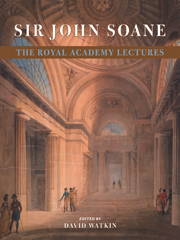Lecture IV
from The Royal Academy Lectures
Published online by Cambridge University Press: 12 October 2018
Summary
MR. PRESIDENT, - The origin, proportions, and application of the different orders of architecture, and also of Persians and caryatides, as used in the external and internal decoration of temples and other public works of the Greeks and Romans, having been already considered, I shall now subjoin a few observations on the further use made by the ancients of that noble part of architectural decoration, the column, a leading feature of each order.
Columns were not limited to the purposes already mentioned; they were often applied to record the actions of great men.
From Homer we learn that Ulysses raised a column on a hillock in memory of Elphenor who broke his neck by falling over a staircase in the Palace of Circe.
Pompey the Great, as we are told by Pliny, erected many trophies and triumphal columns commemorative of his splendid victories. And in another period a column decorated with prows of vessels was dedicated to Duilius, in honour of his having gained the first naval victoryb over the Carthaginians. These instances and the column erected in the centre of Trajan's Forum (pl. 3) as well as the Column of Antoninus at Rome, and that of Theodosius at Constantinople, together with the Temple of Juno, supported by columns on which, according to Pausanias, different traits of fable and history were represented, explain the uses made by the ancients of columns, and may be at the same time considered as so many historical records of antiquity.
So great was the love of the ancients for columns, and so necessary were they considered to the decoration of their temples, that historians tell us it was very common for several of the small Grecian states to join in the expense of building a temple to their favourite divinity, each state separately not having the means of erecting a suitable building. This relation is in some degree established by the remains of a temple at Jackly, where on the shaft of each column there is a small tablet on which is inscribed the name of the person at whose expense it had been presented. So fully impressed were the ancients with the superior beauty of columns that they endeavoured to use them on every possible occasion. In the works of the Egyptians we frequently see porticoes of four, five, and sometimes six rows of columns disposed in parallel lines.
- Type
- Chapter
- Information
- Sir John Soane: The Royal Academy Lectures , pp. 89 - 115Publisher: Cambridge University PressPrint publication year: 2000



